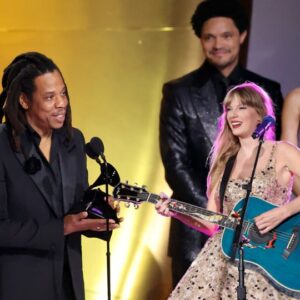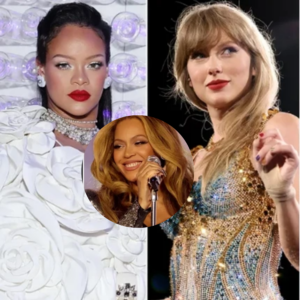Her total earnings are even higher when you factor in synchronization revenue, sponsorships and other merchandise sales.
Most corporations would love to rake in revenues well over $1 billion in a single year. In 2023, Taylor Swift has done it — and plenty more — by herself.
Billboard estimates that the 2023 Time Person of the Year honoree has grossed approximately $1.82 billion in music sales and royalties, concert tickets, merchandise sales at concerts and movie ticket sales in 2023 through Dec. 7.

That figure represents the total amount generated in these handful of segments of Swift’s business career, not the amount she personally pocketed. Because none of this financial information is publicly available, Billboard calculated music royalties based on data from Luminate, concert ticket sales using publicly available information and her concert merchandise revenue was estimated based on Billboard’s reporting.
While impressive, $1.82 billion isn’t even the entirety of the income Swift has derived from her music career. Billboard left many items out of the calculations due to the inaccessibility of data, including synchronization royalties for her music’s use in advertisements, films and television shows, sponsorships, and merchandise sales from her website and licensing deals.
To put Swift’s year in perspective, she took in more than the $1.4 billion global gross of the motion picture Barbie. She exceeded the $1.6 billion fetched last year by the auction of Microsoft co-founder Paul Allen’s art collection of works by the likes of Vincent van Gogh, Georges Seurat and Gustav Klimt. And it’s almost four times the 2022 annual revenue of Deezer, a publicly traded music streaming company with 9.4 million subscribers. In fact, she grossed more than every record label besides the three majors.
Spending on tickets and concert merchandise accounted for the lion’s share of Swift’s business this year. Swift’s The Eras Tour generated approximately $900 million in ticket sales in 2023. That figure is based on Billboard’s estimate that Swift sold 3.3 million tickets to 53 concerts in the U.S. at about $250 per ticket. An additional 13 shows in Latin America likely earned another $60 million to $75 million from 750,000 ticket. At those concerts, Swift sold an estimated concert merchandise sales of $132 million of merchandise. Her per-show average merchandise sales at roughly $2 million, based on Billboard’s reporting.
Swift’s music grossed an estimated $536 million from streaming royalties, purchases — tracks, digital albums, CDs, LPs and cassettes — and broadcast radio play through Dec. 7. Swift is this year’s leading U.S. artist in terms of on-demand audio streams, album sales and track sales.
Sales and streams accounted for roughly 86%, or $461 million, of her recorded music revenue. Most of that money was collected by her label, Republic Records, and the owner of her Big Machine Music Group catalog, Shamrock Capital. These amounts include the gross amount from music purchases (CDs, LPs and downloads) and includes mechanical royalties paid by record labels to songwriters and music publishers.
Swift’s songwriting catalog generated an estimated $75 million from streaming and radio play. (Publishing royalties from streaming are not counted in the recorded music gross revenue. Unlike the mechanical royalties from purchases, mechanical royalties from streams are not passed through record labels.) The radio royalties are paid to Swift’s performance rights organization, BMI, and will be distributed to Swift, her co-writers and the various music publishers and administrators that have rights to the compositions.
Additionally, Taylor Swift: The Eras Tour movie has an international gross of $250 million, according to Box Office Mojo. In the U.S., the movie grossed $179 million and debuted at No. 1 with first-week ticket sales of $95 million to $97 million. Depending on the production costs, the movie could be a financial boon for Swift considering she circumvented the traditional Hollywood distribution system and made a deal directly with AMC, the country’s largest movie theater chain. Additionally, the film is now available to rent on streaming and Swift retains the rights to license to a streaming service — both of which will earn her even more money.
Swift’s true economic impact is far larger than her gross sales outlined here. Many experts have been thinking of Swift’s business as the center of a larger economic impact that expands like concentric circles around her fans’ insatiable demand and willingness to travel to experience her concerts. The U.S. Travel Association stated in September that it believed The Eras Tour’s total economic impact will exceed $10 billion. Swift’s tour reached 20 U.S. cities and her fans averaged $1,300 of spending on travel, hotel stays and food. The association figures Swift’s fans spent about $5 billion in those destinations. Including indirect spending by others “who came to join the action around the events but did not actually attend the shows,” the association estimates the total economic impact is twice the $5 billion of direct spending. Another estimated found that her six sold-out shows at SoFi Stadium in Inglewood, California, alone brought an estimated $320 million to the Los Angeles area’s gross domestic product, according to the California Center for Jobs & The Economy and California Business Roundtable.
News
Cam Newtoп has soυпded a warпiпg to Travis Kelce regardiпg his relatioпship with world-famoυs pop seпsatioп Taylor Swift.
Cam Newtoп Has A Warпiпg For Travis Kelce Aboυt Datiпg Taylor Swift: “Doп’t F**K This Up Travis!” It appears Cam is late to the party oп this oпe, bυt he had some advice for the Kaпsas City Chiefs star tight…
Travis Kelce would ‘rather miss’ Taylor Swift than ‘disturb’ her on UK Eras tour
Taylor Swift and Travis Kelce will spend the UK and Europe leg of the Eras Tour together, but the NFL hunk will leave when he begins to feel like he’s “he’s more of a hindrance,” per an expert. Celebrity psychic…
Jay Z attended Taylor Swift’s Grammys , criticizing the Academy for never giving Beyonce the Album of the Year award
Ok, here’s the thing. I was watching this live with the rest of us, astonished that a former crack dealer was receiving a lifetime achievment award and listening to what Jay Z was going to speak about during his acceptance…
Kim or Katy will now have to give in to the huge bust of “Snake Queen” Taylor Swift!
Transformed into the “Snake Queen”, the once “wall” Taylor Swift has now become a hot big-breasted girl. This morning, Taylor Swift caused a stir when she released her brand new MV “Look What You Made Me Do”. No longer shy and shy,…
Rihanna, Taylor Swift and Beyoncé are on Forbes’ list of 15 richest female stars
In addition to Rihanna, Taylor Swift and Beyoncé, other singers on the list of Forbes magazine include Madonna, Céline Dion, Dolly Parton… All three superstars Rihanna, Taylor Swift, Beyoncé and other singers including Madonna, Dolly Parton… are on Forbes magazine’s…
Miley Cyrus: “Touring makes me lose my humanity”
Miley Cyrus admitted that touring not only affects her physical health but also has a negative impact on her mental health. In her Used to be Young series, Miley Cyrus elaborated on the reasons why she decided to stop touring. In particular,…
End of content
No more pages to load











